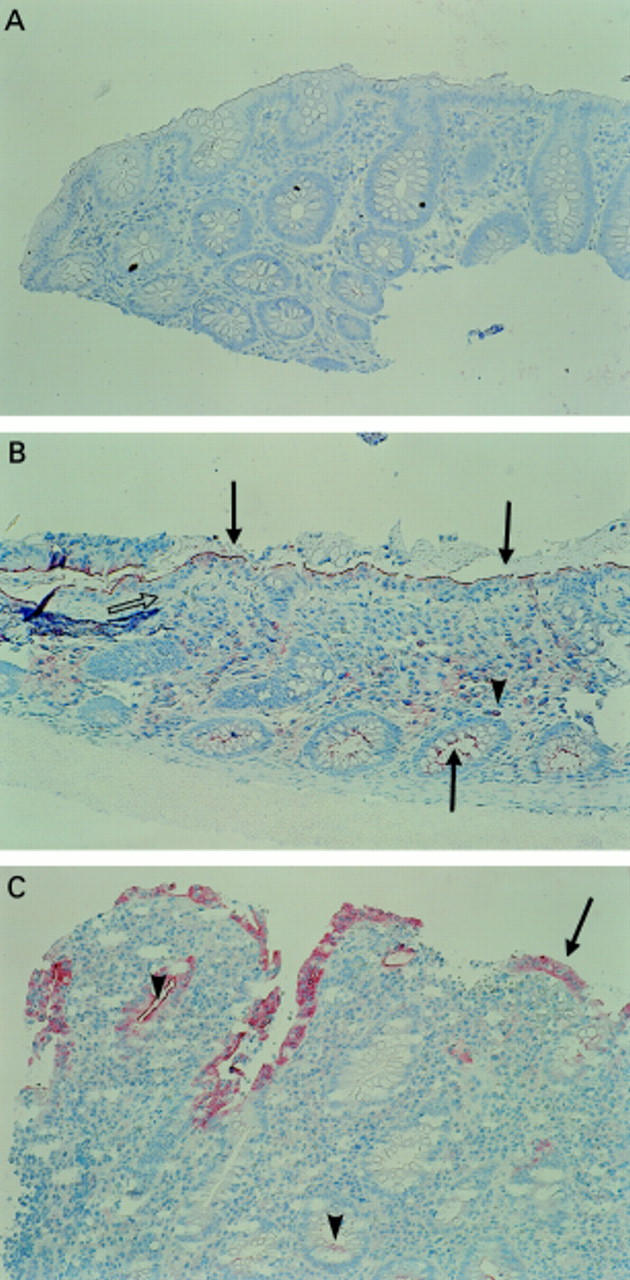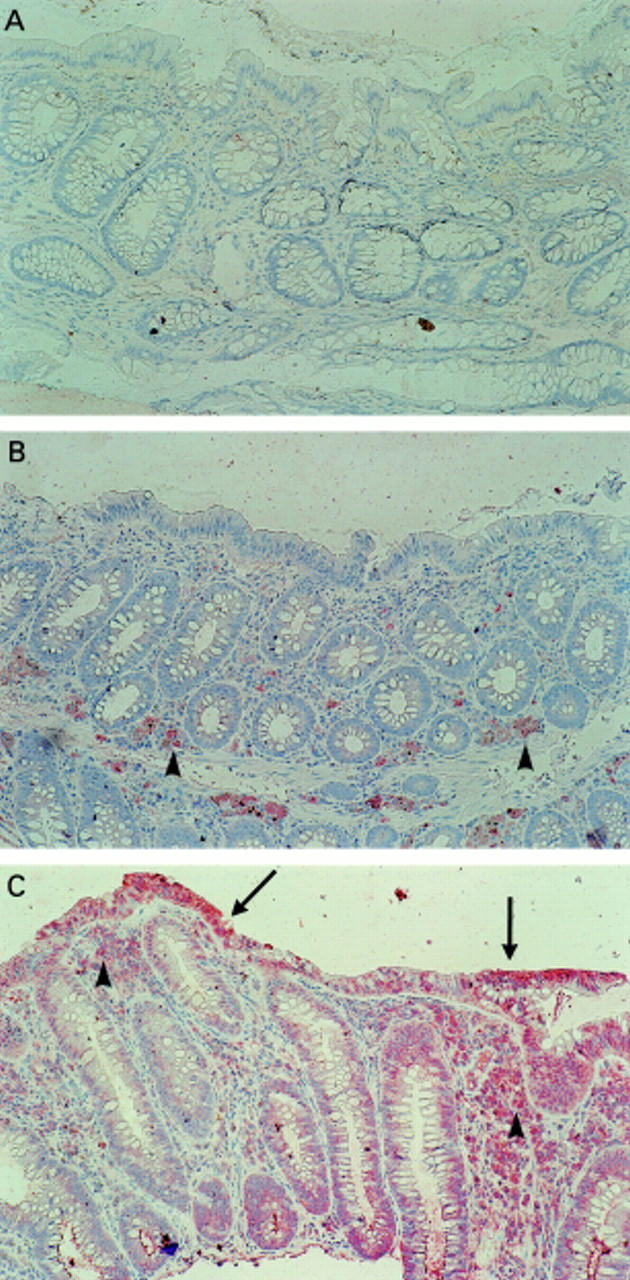Abstract
BACKGROUND AND AIMS—Luminal nitric oxide (NO) is greatly increased in the colon of patients with collagenous and ulcerative colitis. To define the source and consequence of enhanced NO production we have studied expression of NO synthase (NOS) isoforms and nitrotyrosine in mucosal biopsies from these patients. In addition, effects on colonic fluid transfer caused by manipulating the substrate of NOS were studied in patients with collagenous colitis. PATIENTS—Eight patients with collagenous colitis, nine with active ulcerative colitis, and 10 with uninflamed bowel were included. METHODS—Expression of NOS isoforms was quantified by western blotting. Inducible NOS (iNOS) and nitrotyrosine were localised by immunohistochemistry. Modulation of NOS activity by topical NG-monomethyl-L-arginine (L-NMMA) or L-arginine was assessed during perfusion of whole colon. Plasma and perfusate nitrite/nitrate (NOx) was measured by Griess' reaction. RESULTS—Both in collagenous and ulcerative colitis, expression of iNOS was 102-103 higher (p<0.001) than in uninflamed bowel and localised primarily to the epithelium. Endothelial NOS was evenly expressed in all groups while neuronal NOS was undetectable. Nitrotyrosine was markedly expressed in active ulcerative colitis but rarely detected in collagenous colitis and never in uninflamed bowel. In collagenous colitis, the output of NOx was markedly increased compared with uninflamed bowel (283 (58) v <37 nmol/min; p<0.01) and fluid was net secreted. L-NMMA reduced the output of NOx by 13-66% (95% confidence intervals) and secretion of fluid by 25-109% whereas L-arginine increased the output of NOx by 3-39% and secretion of fluid by 15-93%. CONCLUSIONS—In collagenous colitis, as opposed to ulcerative colitis, upregulation of iNOS occurs in the absence of nitrotyrosine formation and mucosal damage. Excess generation of NO may be the primary cause of diarrhoea in this condition. Keywords: colitis; ulcerative colitis; collagenous colitis; inflammatory bowel diseases; large intestine; nitric oxide; nitric oxide synthase
Full Text
The Full Text of this article is available as a PDF (274.7 KB).
Figure 1 .

Expression of inducible nitric oxide synthase (iNOS) and endothelial nitric oxide synthase (eNOS) in mucosal biopsies from patients with collagenous colitis, active ulcerative colitis, or uninflamed bowel. Expression was analysed by western blotting and quantified by densitometry relative to a reference, which was defined as 1.0. For internal control of loading, samples were also blotted against anti-glyceraldehyde 3-phosphate dehydrogenase (GAPDH) antibody. In the scatterplots, the logarithmic y axes define individual values with group means displayed as horizontal lines.
Figure 2 .

Localisation of inducible nitric oxide synthase (iNOS) in mucosal biopsies from human colon analysed by immunohistochemistry and counterstained with haematoxylin. (A) Uninflamed mucosa stained with iNOS IgG antibody (see text). No reaction was observed. (B) Biopsy section from a collagenous colitis patient showing a thickened collagenous band beneath the epithelium (open arrow). The reaction product (red) of iNOS antibody is localised at the luminal border of the epithelial cells (see arrows at surface and crypts) and to a minor degree in lamina propria mononuclear cells (arrowhead). (C) Biopsy from a patient with severe ulcerative colitis at endoscopy showing disturbed mucosal architecture and pronounced infiltration of inflammatory cells. The reaction product of the iNOS antibody is localised primarily in the surface epithelial cells (arrow). A discrete reaction is observed in adjacent neutrophils and in mononuclear cells of the lamina propria. In areas with less intense reaction this is primarily localised in the apical cytoplasm (arrowheads).
Figure 3 .

Localisation of nitrotyrosine in mucosal biopsies from human colon analysed by immunohistochemistry and counterstained with haematoxylin. (A) Uninflamed mucosa stained with nitrotyrosine antibody (see text). No reaction was observed. (B) Biopsy section from a patient with collagenous colitis. The reaction product (red) of the nitrotyrosine antibody is observed within mononuclear cells of the lamina propria (arrowheads). (C) Biopsy section from a patient with ulcerative colitis showing disturbed mucosal architecture and pronounced infiltration of inflammatory cells. The reaction product of the nitrotyrosine antibody is localised in the epithelium (arrows) in association with neutrophils and in lamina propria inflammatory cells (arrowheads)
Selected References
These references are in PubMed. This may not be the complete list of references from this article.
- Beckman J. S., Koppenol W. H. Nitric oxide, superoxide, and peroxynitrite: the good, the bad, and ugly. Am J Physiol. 1996 Nov;271(5 Pt 1):C1424–C1437. doi: 10.1152/ajpcell.1996.271.5.C1424. [DOI] [PubMed] [Google Scholar]
- Binder V. A comparison between clinical state, macroscopic and microscopic appearances of rectal mucosa, and cytologic picture of mucosal exudate in ulcerative colitis. Scand J Gastroenterol. 1970;5(7):627–632. [PubMed] [Google Scholar]
- Boughton-Smith N. K., Evans S. M., Hawkey C. J., Cole A. T., Balsitis M., Whittle B. J., Moncada S. Nitric oxide synthase activity in ulcerative colitis and Crohn's disease. Lancet. 1993 Aug 7;342(8867):338–340. doi: 10.1016/0140-6736(93)91476-3. [DOI] [PubMed] [Google Scholar]
- Devroede G. J., Phillips S. F. Studies of the perfusion technique for colonic absorption. Gastroenterology. 1969 Jan;56(1):92–100. [PubMed] [Google Scholar]
- Dijkstra G., Moshage H., van Dullemen H. M., de Jager-Krikken A., Tiebosch A. T., Kleibeuker J. H., Jansen P. L., van Goor H. Expression of nitric oxide synthases and formation of nitrotyrosine and reactive oxygen species in inflammatory bowel disease. J Pathol. 1998 Dec;186(4):416–421. doi: 10.1002/(SICI)1096-9896(199812)186:4<416::AID-PATH201>3.0.CO;2-U. [DOI] [PubMed] [Google Scholar]
- Eiserich J. P., Hristova M., Cross C. E., Jones A. D., Freeman B. A., Halliwell B., van der Vliet A. Formation of nitric oxide-derived inflammatory oxidants by myeloperoxidase in neutrophils. Nature. 1998 Jan 22;391(6665):393–397. doi: 10.1038/34923. [DOI] [PubMed] [Google Scholar]
- Fang F. C. Perspectives series: host/pathogen interactions. Mechanisms of nitric oxide-related antimicrobial activity. J Clin Invest. 1997 Jun 15;99(12):2818–2825. doi: 10.1172/JCI119473. [DOI] [PMC free article] [PubMed] [Google Scholar]
- Faraci W. S., Nagel A. A., Verdries K. A., Vincent L. A., Xu H., Nichols L. E., Labasi J. M., Salter E. D., Pettipher E. R. 2-Amino-4-methylpyridine as a potent inhibitor of inducible NO synthase activity in vitro and in vivo. Br J Pharmacol. 1996 Nov;119(6):1101–1108. doi: 10.1111/j.1476-5381.1996.tb16010.x. [DOI] [PMC free article] [PubMed] [Google Scholar]
- Gaginella T. S., Mascolo N., Izzo A. A., Autore G., Capasso F. Nitric oxide as a mediator of bisacodyl and phenolphthalein laxative action: induction of nitric oxide synthase. J Pharmacol Exp Ther. 1994 Sep;270(3):1239–1245. [PubMed] [Google Scholar]
- Grisham M. B., Specian R. D., Zimmerman T. E. Effects of nitric oxide synthase inhibition on the pathophysiology observed in a model of chronic granulomatous colitis. J Pharmacol Exp Ther. 1994 Nov;271(2):1114–1121. [PubMed] [Google Scholar]
- Halliwell B. What nitrates tyrosine? Is nitrotyrosine specific as a biomarker of peroxynitrite formation in vivo? FEBS Lett. 1997 Jul 14;411(2-3):157–160. doi: 10.1016/s0014-5793(97)00469-9. [DOI] [PubMed] [Google Scholar]
- Hata F., Ishii T., Kanada A., Yamano N., Kataoka T., Takeuchi T., Yagasaki O. Essential role of nitric oxide in descending inhibition in the rat proximal colon. Biochem Biophys Res Commun. 1990 Nov 15;172(3):1400–1406. doi: 10.1016/0006-291x(90)91605-r. [DOI] [PubMed] [Google Scholar]
- Järnerot G., Tysk C., Bohr J., Eriksson S. Collagenous colitis and fecal stream diversion. Gastroenterology. 1995 Aug;109(2):449–455. doi: 10.1016/0016-5085(95)90332-1. [DOI] [PubMed] [Google Scholar]
- Kimura H., Hokari R., Miura S., Shigematsu T., Hirokawa M., Akiba Y., Kurose I., Higuchi H., Fujimori H., Tsuzuki Y. Increased expression of an inducible isoform of nitric oxide synthase and the formation of peroxynitrite in colonic mucosa of patients with active ulcerative colitis. Gut. 1998 Feb;42(2):180–187. doi: 10.1136/gut.42.2.180. [DOI] [PMC free article] [PubMed] [Google Scholar]
- Kimura H., Miura S., Shigematsu T., Ohkubo N., Tsuzuki Y., Kurose I., Higuchi H., Akiba Y., Hokari R., Hirokawa M. Increased nitric oxide production and inducible nitric oxide synthase activity in colonic mucosa of patients with active ulcerative colitis and Crohn's disease. Dig Dis Sci. 1997 May;42(5):1047–1054. doi: 10.1023/a:1018849405922. [DOI] [PubMed] [Google Scholar]
- Kubes P. Inducible nitric oxide synthase: a little bit of good in all of us. Gut. 2000 Jul;47(1):6–9. doi: 10.1136/gut.47.1.6. [DOI] [PMC free article] [PubMed] [Google Scholar]
- LOWRY O. H., ROSEBROUGH N. J., FARR A. L., RANDALL R. J. Protein measurement with the Folin phenol reagent. J Biol Chem. 1951 Nov;193(1):265–275. [PubMed] [Google Scholar]
- Lazenby A. J., Yardley J. H., Giardiello F. M., Jessurun J., Bayless T. M. Lymphocytic ("microscopic") colitis: a comparative histopathologic study with particular reference to collagenous colitis. Hum Pathol. 1989 Jan;20(1):18–28. doi: 10.1016/0046-8177(89)90198-6. [DOI] [PubMed] [Google Scholar]
- Lindström C. G. 'Collagenous colitis' with watery diarrhoea--a new entity? Pathol Eur. 1976;11(1):87–89. [PubMed] [Google Scholar]
- Lundberg J. O., Hellström P. M., Lundberg J. M., Alving K. Greatly increased luminal nitric oxide in ulcerative colitis. Lancet. 1994 Dec 17;344(8938):1673–1674. doi: 10.1016/s0140-6736(94)90460-x. [DOI] [PubMed] [Google Scholar]
- Lundberg J. O., Herulf M., Olesen M., Bohr J., Tysk C., Wiklund N. P., Morcos E., Hellström P. M., Weitzberg E., Järnerot G. Increased nitric oxide production in collagenous and lymphocytic colitis. Eur J Clin Invest. 1997 Oct;27(10):869–871. doi: 10.1046/j.1365-2362.1997.2230757.x. [DOI] [PubMed] [Google Scholar]
- McCafferty D. M., Mudgett J. S., Swain M. G., Kubes P. Inducible nitric oxide synthase plays a critical role in resolving intestinal inflammation. Gastroenterology. 1997 Mar;112(3):1022–1027. doi: 10.1053/gast.1997.v112.pm9041266. [DOI] [PubMed] [Google Scholar]
- Middleton S. J., Shorthouse M., Hunter J. O. Increased nitric oxide synthesis in ulcerative colitis. Lancet. 1993 Feb 20;341(8843):465–466. doi: 10.1016/0140-6736(93)90211-x. [DOI] [PubMed] [Google Scholar]
- Moncada S., Palmer R. M., Higgs E. A. Nitric oxide: physiology, pathophysiology, and pharmacology. Pharmacol Rev. 1991 Jun;43(2):109–142. [PubMed] [Google Scholar]
- Moochhala S., Chhatwal V. J., Chan S. T., Ngoi S. S., Chia Y. W., Rauff A. Nitric oxide synthase activity and expression in human colorectal cancer. Carcinogenesis. 1996 May;17(5):1171–1174. doi: 10.1093/carcin/17.5.1171. [DOI] [PubMed] [Google Scholar]
- Moshage H., Kok B., Huizenga J. R., Jansen P. L. Nitrite and nitrate determinations in plasma: a critical evaluation. Clin Chem. 1995 Jun;41(6 Pt 1):892–896. [PubMed] [Google Scholar]
- Nathan C., Xie Q. W. Nitric oxide synthases: roles, tolls, and controls. Cell. 1994 Sep 23;78(6):915–918. doi: 10.1016/0092-8674(94)90266-6. [DOI] [PubMed] [Google Scholar]
- Rask-Madsen J. Simultaneous measurement of electrical polarization and electrolyte transport by the entire normal and inflamed human colon during in vivo perfusion. Scand J Gastroenterol. 1973;8(4):327–336. [PubMed] [Google Scholar]
- Ribbons K. A., Currie M. G., Connor J. R., Manning P. T., Allen P. C., Didier P., Ratterree M. S., Clark D. A., Miller M. J. The effect of inhibitors of inducible nitric oxide synthase on chronic colitis in the rhesus monkey. J Pharmacol Exp Ther. 1997 Feb;280(2):1008–1015. [PubMed] [Google Scholar]
- Salzman A., Denenberg A. G., Ueta I., O'Connor M., Linn S. C., Szabó C. Induction and activity of nitric oxide synthase in cultured human intestinal epithelial monolayers. Am J Physiol. 1996 Apr;270(4 Pt 1):G565–G573. doi: 10.1152/ajpgi.1996.270.4.G565. [DOI] [PubMed] [Google Scholar]
- Schirgi-Degen A., Beubler E. Proabsorptive properties of nitric oxide. Digestion. 1998 Jul-Aug;59(4):400–403. doi: 10.1159/000007497. [DOI] [PubMed] [Google Scholar]
- Schmidt H. H., Murad F. Purification and characterization of a human NO synthase. Biochem Biophys Res Commun. 1991 Dec 31;181(3):1372–1377. doi: 10.1016/0006-291x(91)92090-7. [DOI] [PubMed] [Google Scholar]
- Singer I. I., Kawka D. W., Scott S., Weidner J. R., Mumford R. A., Riehl T. E., Stenson W. F. Expression of inducible nitric oxide synthase and nitrotyrosine in colonic epithelium in inflammatory bowel disease. Gastroenterology. 1996 Oct;111(4):871–885. doi: 10.1016/s0016-5085(96)70055-0. [DOI] [PubMed] [Google Scholar]
- Stack W. A., Filipowicz B., Hawkey C. J. Nitric oxide donating compounds stimulate human colonic ion transport in vitro. Gut. 1996 Jul;39(1):93–99. doi: 10.1136/gut.39.1.93. [DOI] [PMC free article] [PubMed] [Google Scholar]
- Tepperman B. L., Brown J. F., Whittle B. J. Nitric oxide synthase induction and intestinal epithelial cell viability in rats. Am J Physiol. 1993 Aug;265(2 Pt 1):G214–G218. doi: 10.1152/ajpgi.1993.265.2.G214. [DOI] [PubMed] [Google Scholar]
- Wallace J. L., Vergnolle N., Muscará M. N., Asfaha S., Chapman K., McKnight W., Del Soldato P., Morelli A., Fiorucci S. Enhanced anti-inflammatory effects of a nitric oxide-releasing derivative of mesalamine in rats. Gastroenterology. 1999 Sep;117(3):557–566. doi: 10.1016/s0016-5085(99)70448-8. [DOI] [PubMed] [Google Scholar]
- Whittle B. J. Nitric oxide--a mediator of inflammation or mucosal defence. Eur J Gastroenterol Hepatol. 1997 Nov;9(11):1026–1032. doi: 10.1097/00042737-199711000-00002. [DOI] [PubMed] [Google Scholar]
- Zingarelli B., Szabó C., Salzman A. L. Reduced oxidative and nitrosative damage in murine experimental colitis in the absence of inducible nitric oxide synthase. Gut. 1999 Aug;45(2):199–209. doi: 10.1136/gut.45.2.199. [DOI] [PMC free article] [PubMed] [Google Scholar]


